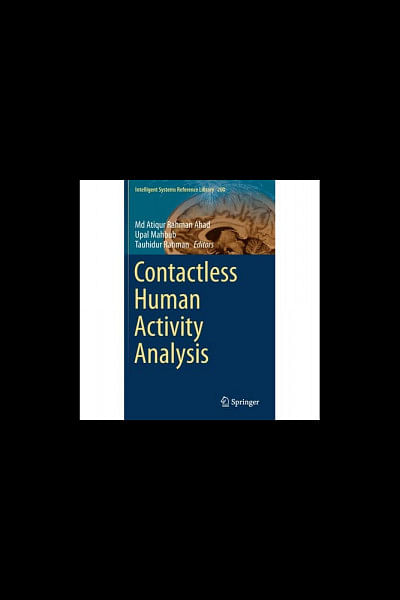‘Contactless Human Activity Analysis’: Future technologies to enable better lives

As the world continues to battle a devastating pandemic, the significance of healthcare technologies can be felt more so than ever. Rapid technological advancement (particularly in the artificial intelligence domain) has been revolutionising this sector, and contactless human activity analysis is one such promising example.
For instance, some may wonder about the underlying technology that enables instant detection of objects and people through surveillance videos. Or how they perform contactless fall detection, vital sign monitoring, and gesture recognition. Are such technologies indeed capable of accurately capturing human emotion?
While plenty of technical and general resources remain available in this domain, it is not that easy to find one single book covering sufficient and up-to-date details, particularly one edited by Bangladeshi researchers.
Contactless Human Activity Analysis (Springer, 2021) is the successful outcome of such an arduous mission by its editors, Dr Upal Mahbub, Dr Tauhidur Rahman, and Dr Md Atiqur Rahman Ahad, published as part of a series on "Intelligent Systems References Library". The book consists of 12 chapters from 15 organisations, including authors from Australia, Bangladesh, China, Japan, the UK, and the USA.
Dr Atiqur Rahman Ahad, a professor at the Department of Electrical and Electronic Engineering in Dhaka University and specially appointed Associate Professor at Osaka University, Japan, has authored four books, published over 130 peer-reviewed papers, provided 80 keynote talks, and received 28 awards and recognitions. Dr Upal, formerly Assistant Professor at the Department of Electrical and Electronic Engineering at BUET and currently a Senior Machine Learning Engineer at Qualcomm in California, has been a regular author-editor-contributor for several top-notch technical platforms. Dr Tauhidur, currently Assistant Professor at the University of Massachusetts Amherst, has already received widespread recognition for his research on mobile health technology (receiving press coverage in Wall Street Journal, NewScientist, and MIT Technology Review, among others).
In its first two chapters, the book covers two interesting topics—vision-based and skeleton-based activity recognition—and explores key methods, datasets, performance metrics, and challenges and applications. Gradually, readers enter into further technical details such as widely used signal processing techniques, applications like computational imaging, vital sign monitoring and gesture recognition using Wi-Fi, contactless fall detection for the elderly, contactless human emotion analysis, activity recognition for dementia, and craft-based human computer interaction. In the last two chapters, the editors themselves discuss the challenges and future direction of contactless human monitoring. All these chapters are well-supported by illustrations, tables, datasets, and reference materials.
The book covers sufficient depth of technical detail while maintaining a lucid tone. They simultaneously discuss relevant non-technical aspects also. The book thus provides a highly enriched narrative on contactless human activity analysis, which is becoming increasingly critical for a transparent and healthy life.
This book can be a good source of insights for scientists and engineers in their advanced or mid-career, as well as for any enthusiastic reader with basic knowledge of this field. It can be a valuable addition to library catalogues of technological universities and institutions across the country.
Considering the speedy developments that are common occurences in this domain, the contents of this book should be regularly updated in subsequent editions. Along with existing examples, in future the authors may consider adding some detailed real-life case studies which depict how the theoretical frameworks get implemented in practical scenarios.
Very recently we have been inspired by some exceptional success stories in science. Three Bangladeshi researchers have been included in this year's list of Asia's top 100 scientists. While the oxygen crisis has been catastrophic in some countries during this COVID-19 pandemic, a group of BUET researchers has developed a low-cost portable ventilator for efficiently delivering oxygen to patients without electricity.
So, a technology-based book of superior global standard, produced by Bangladeshi scientists, engineers, and researchers, can hopefully edify us further and strengthen us with spirit.
Azfar Adib is an ICT analyst & activist. He is a Senior Member of the Institute of Electrical and Electronic Engineers and currently a PhD student at Concordia University, Canada.

 For all latest news, follow The Daily Star's Google News channel.
For all latest news, follow The Daily Star's Google News channel. 



Comments